A train at 11 takes me to Zaventem via Brussels Midi for my Brussels Airlines flight at 3 pm.
My friend, and host, Deborah is meeting me at Fiumicino Airport.
We take the train to Ostiense, where Deborah lives, not too far from the Centro Storico.
 Walking from Ostiense station we pass the Piramide di Caio Cestio near the Porta San Paolo, one of the gates in the 3rd-century Aurelian Walls. It stands at a fork between two ancient roads, the Via Ostiensis and another road that ran west to the Tiber along the approximate line of the modern Via della Marmorata.
Walking from Ostiense station we pass the Piramide di Caio Cestio near the Porta San Paolo, one of the gates in the 3rd-century Aurelian Walls. It stands at a fork between two ancient roads, the Via Ostiensis and another road that ran west to the Tiber along the approximate line of the modern Via della Marmorata.  Due to its incorporation into the city's fortifications, it is today one of the best-preserved ancient buildings in Rome.
Due to its incorporation into the city's fortifications, it is today one of the best-preserved ancient buildings in Rome.


 |
A nice evening walk takes us to the Piazza Albania, where there is an equastrian statue of Giorgio Castriota Scanderberg, an Albanian hero, Chief of the League of the Albanian people who defended the region of Albania against the Ottoman Empire for 25 years.


 |
| Via San Anselmo |

Past the piazza Cavalieri di Malta, along the Via di San Sabina and the Basilica (closed), we reach a popular spot for watching the sunset, over the Tevere, with a spectacular view.


By then it was too dark to take pictures, we take a taxi back home, where we have delightful dinner of asparagus.


We left on foot along the Viale Aventino, crossed the via del Circo Massimo into the via di San Gregoria, where the entrance to the Palatino

I got free entrance with my Guide pass.
 Sandwiched between the Roman Forum and the Circo Massimo, the Palatino (Palatine Hill) is an atmospheric area of towering pine trees, majestic ruins and memorable views. It was here that Romulus supposedly founded the city in 753 BC, and Rome's emperors lived in unabashed luxury.
Sandwiched between the Roman Forum and the Circo Massimo, the Palatino (Palatine Hill) is an atmospheric area of towering pine trees, majestic ruins and memorable views. It was here that Romulus supposedly founded the city in 753 BC, and Rome's emperors lived in unabashed luxury.
As the most central of Rome's seven hills, and because it was both close to and above the Roman Forum, the Palatino was the ancient city's most exclusive neighborhood. The emperor Augustus lived here all his life and successive emperors built increasingly opulent palaces. However, after Rome's decline it fell into disrepair, and in the Middle Ages churches and castles were built over the ruins. During the Renaissance, members of wealthy families established gardens on the hill.
Most of the Palatino as it appears today is covered by the ruins of Emperor Domitian's vast complex, which served as the main imperial palace for 300 years.
Divided into the Domus Flavia, Domus Augustana (the emperor's private residence) and a stadio, it was built in the 1st century AD.











The grey building near the Domus Augustana houses the
Museo Palatino
and its collection of archaeological artifacts.
The Palatine Museum charts the history of the hill from Archaic times with quaint models of early villages (ground floor) through to Roman times (ground and upper floors).
 On display in Room V are painted terra-cotta moldings and sculptural decorations from various temples (notably the Temple of Apollo Actiacus, whose name derives from the god to whom Octavian attributed his victory at Actium; the severed heads of the Medusa in the terra-cotta panels symbolize the defeated Queen of Egypt).
On display in Room V are painted terra-cotta moldings and sculptural decorations from various temples (notably the Temple of Apollo Actiacus, whose name derives from the god to whom Octavian attributed his victory at Actium; the severed heads of the Medusa in the terra-cotta panels symbolize the defeated Queen of Egypt).  |
| Statue of nymph seated on a rock (late Flavian period AD 69-96) |

 |
| Seated statue of Magna Mater (mid 2nd century AD, pentelic marble) |

 |
| relief with three goddesses (1st cent AD) |
 |
| Statue of Aphrodite |




 |
| Fresco with apollo playing the lyre (Augustan period, 27 BC-AD 14) |
 |
| Marble Wings (Augustan period) |




 The view is spectacular,
The view is spectacular,no need to visit the nearby Forum and Colosseum.




We decide to take a taxi to the Piazza Navona,
but stop first at the Campo dei Fiori


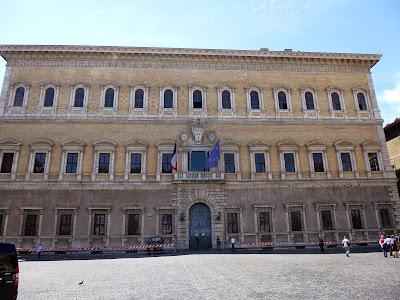 A nice walk all around takes us past the Palazzo Farnese one of the
most important High Renaissance palaces in Rome.
A nice walk all around takes us past the Palazzo Farnese one of the
most important High Renaissance palaces in Rome.
First designed in 1517 for the Farnese family, the
building expanded in size and conception when Alessandro Farnese became Pope
Paul III in 1534, to designs by Antonio da Sangallo the Younger.
Its building
history involved some of the most prominent Italian architects of the 16th
century, including Michelangelo.
Owned by the Republic of Italy, it was given to the French Government in 1936 for a period of 99 years, and currently serves as the French embassy.

The beautiful staircase of the Palazzo del Gall di Roccagiovine. The palace was built in 1520 by Baldassarre Peruzzi (the same architect/artist who designed Villa Farnesina and decorated the ceiling in the first room - the horoscope - and did the trompe l'oeil etc in the big room upstairs, along with the frieze with the labours of Hercules and other myths in the room downstairs off the Cupid and Psyche room.) The text goes on: "Opening onto the courtyard like a loggia, the staircase climbs up three floors and has a slightly slanted double ramp. It is decorated with columns, pilasters and a marble and stucco balustrade." It turns out that the staircase belongs to a 1720 restoration of the building by an architect called Alessandro Specchi. He "...designed the surprising staircase, based on a concept that was entirely new with respect to the traditional main staircases inside buildings."
 With its ornate fountains, baroque palazzi (mansions) and colourful cast of street artists, hawkers and tourists, Piazza Navona
With its ornate fountains, baroque palazzi (mansions) and colourful cast of street artists, hawkers and tourists, Piazza Navona
is central Rome’s showcase square. Built over the 1st-century Stadio di Domiziano (Domitian’s Stadium), it was paved over in the 15th century and for almost 300 years hosted the city's main market.
 Its grand centrepiece, Bernini’s Fontana dei Quattro Fiumi , is an ornate, showy work depicting personifications of the rivers Nile, Ganges, Danube and Plate.
Its grand centrepiece, Bernini’s Fontana dei Quattro Fiumi , is an ornate, showy work depicting personifications of the rivers Nile, Ganges, Danube and Plate.
Legend has it that the figure of the Nile is shielding his eyes from the Chiesa di Sant'Agnese in Agone , designed by Bernini's bitter rival, Borromini.
The more prosaic truth is that Bernini completed his fountain two years before his contemporary started work on the facade and the gesture simply indicates that the source of the Nile was unknown at the time.
Bernini added the Moor holding a dolphin in the mid-17th century, and the surrounding Tritons are 19th-century copies.

Sant'Agnese in Agone is a 17th-century baroque church facing onto the Piazza Navona, the site where the Early Christina Saint Agnew was martyred. Construction began in 1652 under the architects f ather & son Rainaldi. After numerous quarrels, the other main architect involved was Francesco Borromini.
 Our next church visit is to the
Our next church visit is to the San Nicola die Lorenesi

 By then we are rather hungry, and hurry to the one of Deborah's preferred restaurants, where she has made a reservation.
By then we are rather hungry, and hurry to the one of Deborah's preferred restaurants, where she has made a reservation.


The ancient Romans venerated the Lares, tutelary spirits of the house, in the form of small statues (of men and women), put in high places. These spirits protected also the roads and their statues were placed at road intersections. This practice is at the root of the very large number of sacred images which populated (and to some extent still populate) the streets of Rome.

The majority of the images were positioned on the line marking the separation between the ground floor and the first floor.
In many cases the images were placed at the corner of a building. Because very often an oil-lamp shed some light on the Madonnelle, they constituted for centuries the only public lighting available in Rome.
 Via dei Coronari (known
colloquially in Rome as I Coronari) is a street in the historic center of
Rome. The road, flanked by buildings mostly erected in the 15th and the 16th
century, belongs entirely to the rione Ponte and is one of the most picturesque
roads of the old city, having maintained the character of an Italian Renaissance
street.
Via dei Coronari (known
colloquially in Rome as I Coronari) is a street in the historic center of
Rome. The road, flanked by buildings mostly erected in the 15th and the 16th
century, belongs entirely to the rione Ponte and is one of the most picturesque
roads of the old city, having maintained the character of an Italian Renaissance
street.The road existed already in the Roman age, when it was part of the straight road correspondent to the modern axis Via delle Coppelle – Via dei Coronari, known under the arbitrary name of Via recta ("straight road")


During the Renaissance, the street was smoothed and paved
by pope Sixtus IV (r. 1471–84).
As in other roads of the city, the pope ordered
that all the porticoes which flanked the street be walled up, consequently the
street lost its medieval character.

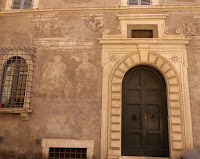

High prelates, nobles and merchants, attracted by the fiscal advantages promised by the pope to those who had built there, erected their elegant houses and palaces here, whose façades were often adorned with sgraffito paintings.

 |

La Maddalena is a 17th century convent church, just north of the Pantheon
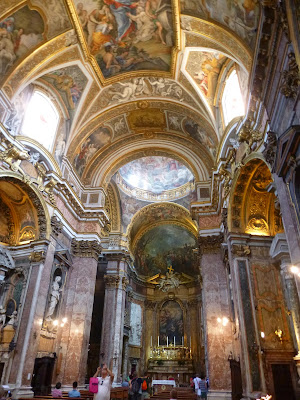

 |
| La Madonna della Salute Coronata dal Capitolo Vaticano ne 1668. |


In the center of the piazza della Rotondo, facing the Pantheon, is a fountain, the Fontana del Pantheon, surmounted by an Egyptian obelisk.
 The fountain was constructed by Giacomo Della Porta under Pope Gregory XIII on 1575, and the obelisk was added to it in 1711 under Pope Clement XI.
The fountain was constructed by Giacomo Della Porta under Pope Gregory XIII on 1575, and the obelisk was added to it in 1711 under Pope Clement XI. 
The Pantheon is the most preserved and influential building of ancient Rome. It was a Roman temple dedicated to all the gods of pagan Rome. As the brick stamps on the side of the building reveal it was built and dedicated between A.D 118 and 125.
The emperor Hadrian (A.D 117-138) built the Pantheon to replace Augustus’ friend and Commander Marcus Agrippa’s Pantheon of 27 B.C. which burnt to the ground in 80 A.D.


The Pantheon was later converted into the church of Santa Maria ad Martyres.
 Until the 20th century, the Pantheon was the largest concrete structure in the world. Michelangelo studied its great dome before starting work on the dome of St.Peter's Basilica.
Until the 20th century, the Pantheon was the largest concrete structure in the world. Michelangelo studied its great dome before starting work on the dome of St.Peter's Basilica.
The Pantheon is the burial place of several important Italians (including the artist Raphael), and it remains an active church. It is a major tourist destination and a popular place for weddings.
The Italian kings Vittorio Emanuele II and Umberto I as well as the famous Renaissance painter Raphael and his fiancée are buried in the Pantheon. It is a wonderful example of second century Roman architecture. It boasts mathematical genius and simple geometry that today still impresses architects and amazes the eyes of casual viewers. Vieuw of the back wall of the Pantheon.
Vieuw of the back wall of the Pantheon.
On the Piazza della Minerva, stands the only Gothic church in Rome, the Basilica Santa Maria sopra Minerva (Basilica of St. Mary over Minerva) is so named because it was built directly on the foundations of a temple to Minerva, the goddess of wisdom.
 The basilica that stands today was begun in 1280. Architectural changes and redecorations in the 1500s and 1900s stripped it of some of its magnificence, but it still includes an awe-inspiring collection of medieval and Renaissance tombs.
The basilica that stands today was begun in 1280. Architectural changes and redecorations in the 1500s and 1900s stripped it of some of its magnificence, but it still includes an awe-inspiring collection of medieval and Renaissance tombs. Santa Maria sopra Minerva has a remarkably plain facade(17th-century), with three small portrals and three round windows. This belies the richness and size of the interior beyond.
Santa Maria sopra Minerva has a remarkably plain facade(17th-century), with three small portrals and three round windows. This belies the richness and size of the interior beyond.
Inside, the viewer's eye is immediately drawn to the arched vaulting, painted blue with gilded stars and accented with brilliant red ribbing. The former is a 19th century restoration in the Gothic style.


The frescoes of the Annuciation, Assumption, and stories from the life of Thomas Aquinas. are painted by Filippino Lippi.
 Saint Catherine of Siena (1347-1380), patroness of Europe, is buried under the altar (except her head, which is in Siena). The tomb includes an effigy of the virgin saint sculpted in 1430 by Isaia of Pisa.
Saint Catherine of Siena (1347-1380), patroness of Europe, is buried under the altar (except her head, which is in Siena). The tomb includes an effigy of the virgin saint sculpted in 1430 by Isaia of Pisa. The great monastic painter Fra Angelico died in the adjoining Dominican monastery and is buried in the Frangipane Chapel to the left of the altar choir.
The great monastic painter Fra Angelico died in the adjoining Dominican monastery and is buried in the Frangipane Chapel to the left of the altar choir.  His tomb features an inset effigy of the artist in repose but with eyes open, also by Isaia of Pisa.
His tomb features an inset effigy of the artist in repose but with eyes open, also by Isaia of Pisa.  The elephant carrying an obelisk on its back was sculpted by Bernini in 1667. It is said to represent Pope Alexander VII's reign and illustrate the moral that strength should support wisdom. The Egyptian obelisk is much older - it was found in the ruins of a temple of Isis that once stood nearby. Nothing visible remains of the Temple of Minerva (or Isis) over which the present church was built, but some Roman remains are visible in the crypt.
The elephant carrying an obelisk on its back was sculpted by Bernini in 1667. It is said to represent Pope Alexander VII's reign and illustrate the moral that strength should support wisdom. The Egyptian obelisk is much older - it was found in the ruins of a temple of Isis that once stood nearby. Nothing visible remains of the Temple of Minerva (or Isis) over which the present church was built, but some Roman remains are visible in the crypt.


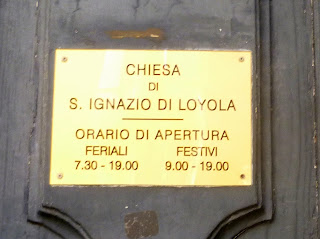

 The Church of St. Ignatius of Loyola at Campus Martius is dedicated to Ignatius of Loyola, the founder of the Societu of Jesus. Built in Baroque style between 1626 and 1650, the church functioned originally as the chapel of the adjacent Roman College.
The Church of St. Ignatius of Loyola at Campus Martius is dedicated to Ignatius of Loyola, the founder of the Societu of Jesus. Built in Baroque style between 1626 and 1650, the church functioned originally as the chapel of the adjacent Roman College.



The church is ancient – it was restored by ope Gregory III in the 8th century, and thus must have existed before then. It is also referred to as Santa Maria della Visitazione, notably by Pope Urban VI in 1389.
 |
| Capella della Pietà Deposition from the Cross, Crowning with the crown of thorns, and Flagellation of Christ (1635-1640) by Gerard van Honthorst "Gherardo della Notti" |


Cardinal Giulio di Giuliano de' Medici (the later Pope Clement VII) ordered a church to be built in 1518, not only to serve the French community living in Rome but also as the seat of his cardinalship. King Henry II of France married to Catherine de Medici, great niece to Giulio, donated funds for its construction.
The site chosen was a small church named Santa Maria owned by Medici family. Santa Maria had been built on the ruins of the Baths of Nero and the Baths of Agrippa, and had long served the French community in Rome, which operated a hospital for the infirm on the site.
The site chosen was a small church named Santa Maria owned by Medici family. Santa Maria had been built on the ruins of the Baths of Nero and the Baths of Agrippa, and had long served the French community in Rome, which operated a hospital for the infirm on the site.
Cardinal Giulio commissioned the architect, Jean de Chenevière, to build the church, based on plans by Giacomo della Porta, who had built Santissima Trinità dei Monti (the church at the top of the Spanish Steps). Construction of the church was halted in 1527, when Rome was sacked by troops of the Holy Roman Emperor, Charles V. Building was resumed in 1580 under the direction of the architect Domenico Fontana, who had completed the Dome of Saint Peter's.
Since the patron saint of France is King Louis IX, the church was dedicated to him, hence San Luigi. The French kings Henry II, Henry III and the latter's mother, Catherine de' Medici, donated funds for its completion. It was consecrated in 1589, the year Catherine died.
Credit for the façade goes to Giacomo della Porta, who also designed the façade of Il Gesu. Carved from lovely white travertine marble, the façade has two levels (or orders), on top of which sits a small peak. The coat of arms at the top belongs to the Valois Family, and carvings of salamanders represent King Francois I of France, who was the French monarch when the foundation was laid. Four statues depict Charlemagne, St. Louis, St. Clotilde (5th century Queen of the Franks), and St. Joan of Valois (daughter of Louis XI).
 The plan of the church is a basilica, that is, a rectangular shape without a transept. Originally a Counter-Reformation church, it would have been quite austere. However, the wealth of the Medicis and the French kings resulted in its subsequent lavish decoration. A number of famous Italian and French artists worked on the interior. Charles Joseph Natoire, whose works also adorn Versailles palace, painted the ceiling fresco (1754), which depicts San Luigi ascending into heaven. It is surrounded by one of the richest and most ornate coffered ceilings in Rome.
The plan of the church is a basilica, that is, a rectangular shape without a transept. Originally a Counter-Reformation church, it would have been quite austere. However, the wealth of the Medicis and the French kings resulted in its subsequent lavish decoration. A number of famous Italian and French artists worked on the interior. Charles Joseph Natoire, whose works also adorn Versailles palace, painted the ceiling fresco (1754), which depicts San Luigi ascending into heaven. It is surrounded by one of the richest and most ornate coffered ceilings in Rome.
Caravaggio's three paintings in the Contarelli Chapel changed the way that people looked at painting and influenced countless artists who followed.
The artist Cavalier D'Arpino received a commission to decorate the chapel for the French Cardinal Matteu Contreil (in Italian, Matteo Contarelli). Caravaggio was working as an apprentice for D'Arpino at the time, and when D'Arpino became too busy to complete the decoration, Caravaggio's patron, Cardinal Francesco del Monte, helped attain the commission for the artist.
Contarelli's will stated that the chapel contain works depicting the life of St. Matthew, Contarelli's namesake (Matteo is the Italian form of Matthew). The will was quite specific as to what should be painted - Saint Mathew's calling by Jesus; his divine inspiration to write his gospel; and his martyrdom. Caravaggio had never worked on such large canvasses before, and X-rays reveal he reworked the paintings a number of times.
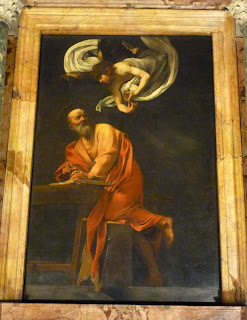 The third painting, above the altar, The Inspiration of Saint Matthew, is not the painting Caravaggio originally created for this location. His first submission, entitled The Angel and Saint Matthew, hung in the chapel only a few days before the priests took it down. The reason? The priests said it had "neither the decorum nor the appearance of a saint."
The third painting, above the altar, The Inspiration of Saint Matthew, is not the painting Caravaggio originally created for this location. His first submission, entitled The Angel and Saint Matthew, hung in the chapel only a few days before the priests took it down. The reason? The priests said it had "neither the decorum nor the appearance of a saint."
In this painting, the saint sits with his legs crossed and his bare left foot extending out toward the viewer. An angel, a winged young boy, whispers into Matthew's ear while guiding his hand in writing his gospel. Sadly, this work survives only as a black and white photograph. The original perished in a museum in Berlin at the close of World War II.
Caravaggio took the rejection hard, but created another masterpiece to replace it, which hangs there to this day. Two figures appear in the painting - St Matthew, at his table poised with pen in hand, and an angel hovering above him, inspiring him to write. Matthew is looking up and over his left shoulder at the angel. He is not seated. Instead one knee rests on a seat and his bare foot dangles. It looks as if he just ran to the table eager and awestruck to complete his gospel. The angel, encircled by floating, heavenly garments, is looking down, enumerating with his fingers the points he wants the saint to record in the gospel. The indistinct background is so dark the figures seem three-dimensional. It's a beautiful painting, and one's eye follows the lines from the angel's garments to the saint's forehead and then down along his robes to the ground.
 On the opposite wall hangs The Martyrdom of Saint Matthew.The scene shows St. Matthew, who had just been celebrating Mass, seconds before a soldier sent by the King of Ethiopia plunges a sword into him. Legend has it that St. Matthew converted the Ethiopian royal family to Christianity, but when Matthew preached a sermon on the virtues of virginity shortly before a prince's wedding, it so enraged the bridegroom that he ordered St. Matthew executed. At the moment of death, an angel appears before Matthew, and extends a palm frond toward him, reassuring the saint of his place in heaven. Contarelli wished to show the effect of the martyrdom on the onlookers. One flees, turning look back with an expression of terror on his face. Others stagger back or cower in fear. One figure to the left of the angel is actually a self-portrait by Caravaggio, notable for the look of sadness in his eyes. One scholar described the look this way: "[he is] contemplating and searching himself for responses to the scene to which he is witness."
On the opposite wall hangs The Martyrdom of Saint Matthew.The scene shows St. Matthew, who had just been celebrating Mass, seconds before a soldier sent by the King of Ethiopia plunges a sword into him. Legend has it that St. Matthew converted the Ethiopian royal family to Christianity, but when Matthew preached a sermon on the virtues of virginity shortly before a prince's wedding, it so enraged the bridegroom that he ordered St. Matthew executed. At the moment of death, an angel appears before Matthew, and extends a palm frond toward him, reassuring the saint of his place in heaven. Contarelli wished to show the effect of the martyrdom on the onlookers. One flees, turning look back with an expression of terror on his face. Others stagger back or cower in fear. One figure to the left of the angel is actually a self-portrait by Caravaggio, notable for the look of sadness in his eyes. One scholar described the look this way: "[he is] contemplating and searching himself for responses to the scene to which he is witness." The painting on the left, The Calling of St Matthew, takes place indoors where Saint Matthew, then a finely dressed moneychanger, sits with a group of common types. Jesus has just entered the dark room, raised his arm, and uttered the words "Follow me," (Matthew 9:9). The saint looks up, incredulous with an expression as if to say, "Who, me?"
The painting on the left, The Calling of St Matthew, takes place indoors where Saint Matthew, then a finely dressed moneychanger, sits with a group of common types. Jesus has just entered the dark room, raised his arm, and uttered the words "Follow me," (Matthew 9:9). The saint looks up, incredulous with an expression as if to say, "Who, me?"
The composition contributes to the drama of the scene. A source of light above and behind Jesus' head slashes the darkness and slants down to illuminate the saint's face. As in many of his religious works, Caravaggio's subjects are depicted at the moment of a miraculous event. However, the contrast between the light of the illumined figures and their surroundings, which become almost indistinguishable as they recede into the dark, increases the dramatic tension of the work. This play of light and dark in painting is called chiaroscuro, and Caravaggio's particular form became known as tenebrism (tenebre meaning "shadow" in French.)
Basilica di San Agostino
 Sant'Agostino is one of the first Roman churches built during the Renaissance.
The façade was built in 1483 by Giacomo di Pietrasanta, using travertine taken
from the Colloseum The design of the church is attributed to the late 15th
century, with later 18th century restorations
Sant'Agostino is one of the first Roman churches built during the Renaissance.
The façade was built in 1483 by Giacomo di Pietrasanta, using travertine taken
from the Colloseum The design of the church is attributed to the late 15th
century, with later 18th century restorations The most famous work of art presently in the church is the Madonna di Loreto, an important baroque painting by Caravaggio.
Caravaggio had been on a sort of pilgrimage to Loreto, which seems to have been an exercise in genuine piety even though he got into trouble on it through his usual violent behaviour which features in contemporary police reports. The shrine of the Holy House in Loreto by tradition has the actual dwelling of the Holy Family in Nazareth, miraculously transported to here by angels. The picture that resulted from the trip caused Cavaletti to change the dedication of the chapel from the former one which had been to the Pietà.
 |
| Fresco of the Prophet Isaias by Raphael |
 |
|
Pietro Bracci designed and sculpted
the polychromatic tomb of
Cardinal Giuseppe Renato Imperiali (1741).
|
















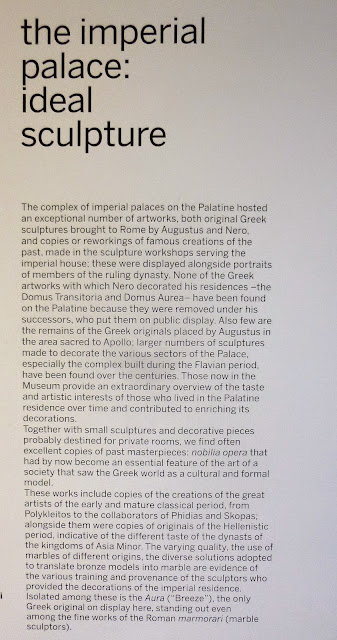














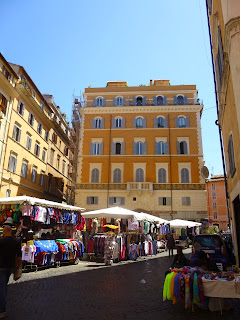


























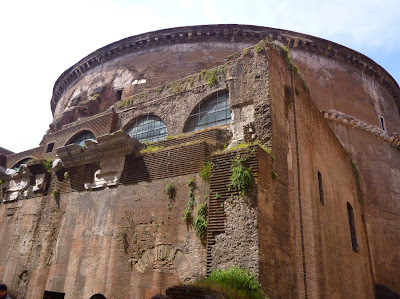











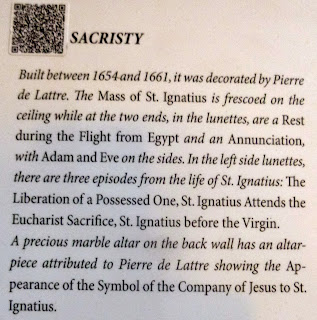

















Geen opmerkingen:
Een reactie posten